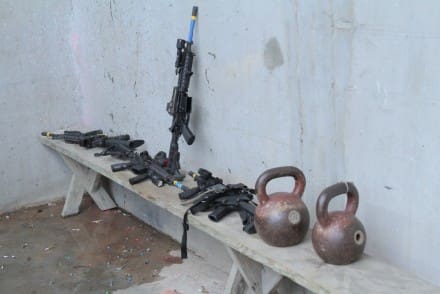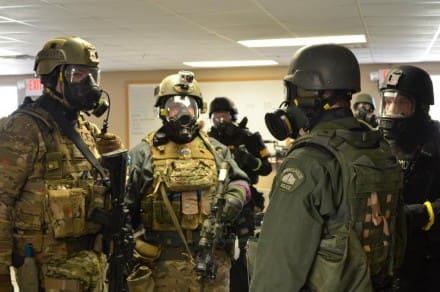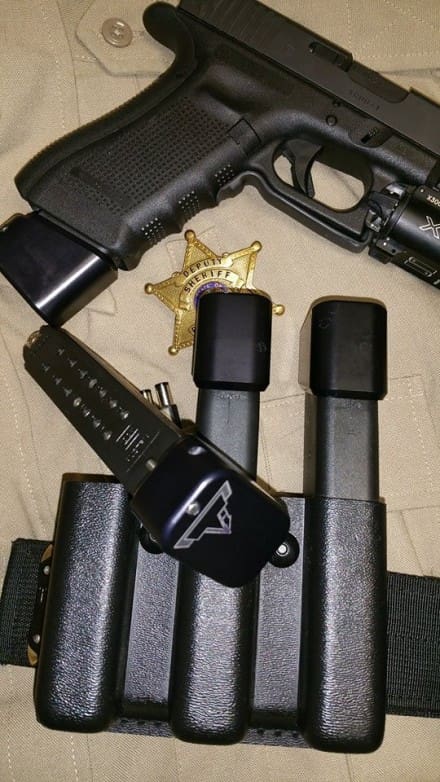We’d like to welcome Matt Landfair, Veteran Police officer, firearms/tactics instructor and founder of primaryandsecondary.com. It’s not the kind of thing you’d generally see on SSD, but we thought it was worth a share.
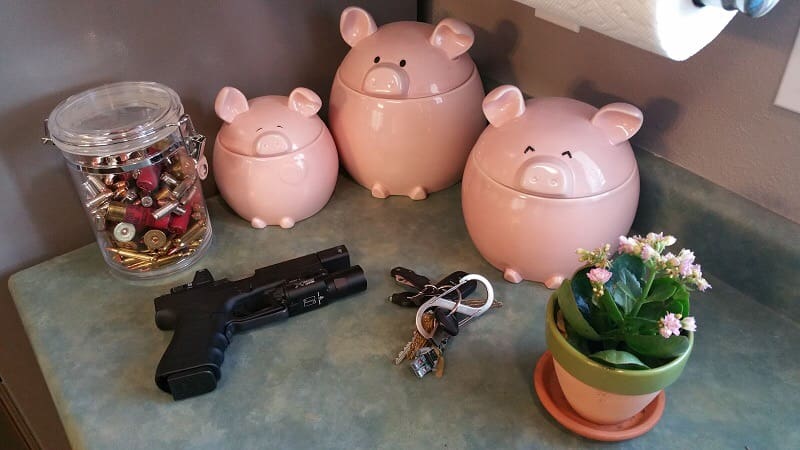
The ability to protect ourselves and our loved ones at home is of paramount importance. With this in mind it is best to understand the options available to maximize your effectiveness if you need to use deadly force in defense of yourself and your family while at home.
Before delving into weapons, it is important to understand the need to have a plan already established and practiced before you need to use it. If you hear that bump in the night, or you hear an obvious entry into your home or hear people that don’t belong – do you call 911, bunker down with a weapon and lock yourself in? Do you arm yourself and investigate? If family members (specifically children) are in other rooms, can you communicate with them or reach them without putting yourself or them in potential danger?
Whether you bunker down or investigate you need the ability to identify potential threats. Optimally we all have night vision goggles with infrared lasers mounted to our weapons so we don’t give away our positions, but not many have that luxury. For the rest of us normal people, we need light. That light can be activated by a wall switch, a handheld flashlight, or a weapon mounted light. Don’t depend on any one option of these. Have backups in place because you might not be able to reach a switch, power might be out, batteries might be dead in the flashlight, etc.
Half of our life (roughly) is in the dark. Sure we might be asleep during most of that darkness, but we know it isn’t scary. We also know the layout of our homes, minus the Legos and toys on the floor that reposition themselves frequently. We know where people would be during the day or in the middle of the night. This knowledge helps us as the protector of our family.
We still need to act safely in defense of our home and loved ones when we handle weapons.
An unloaded weapon is of no use in this situation, treat it accordingly. If you are afraid of handling loaded weapons, or you prefer to keep the chamber unloaded during your investigation of the potential intruder, you should not be responding to anything with firearms. Please get professional training as soon as possible to help you become more comfortable with a loaded weapon.
Never point your firearm at anything you are not willing to kill/destroy/pay for – this also applies to people on the other side of walls. Point the weapon at the bad guy, not an innocent or your kids/spouse.
Always be sure of your target including thing in front and behind it. This is an important aspect of the rules. You need to be able to identify the intruder is a threat and not your child who got up for a glass of water, or your teen who is trying to sneak back into/out of the house late at night. This is where light is important. Again, we know the layout of our homes, we know where people might be, take that into consideration if you need to fire indoors. Be aware of the X, Y, and Z axis of where your projectiles might go.
Triggers are not touched until you are on target and you have made the conscious decision to fire. At this point you have positively identified this is a threat using light and you will press the trigger to stop the threat OR you have positively identified the person not to be a threat – you do not touch the trigger.

This is not a wall you want rounds entering.
Now that the safety rules are out of the way, you need to go through each rule while you do a walkthrough of your response to an intruder within your home. This is the time to think about those walls that can’t be a backstop to your weapon’s fire. Know the longest open distance within your home. This is a distance that you should be able to engage targets and achieve intended accurate hits. Does your flashlight or weapon light illuminate that far end of the house sufficiently to determine if there is a threat – would you be able to see what is in their hands? If you are using a shotgun, do you know what type of pattern will be produced with the shotgun shells you use for home defense at that distance? Don’t only train for this distance; the ability to shoot further and closer are important. Don’t set yourself up for failure by assuming there will only be one intruder or home invasions only occur at night.
I mentioned the need for training. To maximize your effectiveness and efficiency with your task as home defender, you need training. You need training with the weapon you are going to use. Truly this is unavoidable, but it is also rewarding and enjoyable. Instruction from a professional is the responsible step as a firearm user.
Now is the time for the information that can either educate or upset people. If you find you are upset by any of this information please assess it, check it, and go test it. People who are emotionally attached to this stuff have a difficult time accepting fact.
There are three possible factors that stop the bad guy- psychological (giving up – which we have no control over), bleed out (which does not immediately stop the fight), and a shot to the brain (instant stoppage). Those are the only ways to stop the bad guy- no kinetic or hydrostatic or magic. I forgot to mention, warning shots do not stop the bad guys – don’t do it.
Our weapon choices are really limited to three main categories: pistol, shotguns, and carbines/rifles.
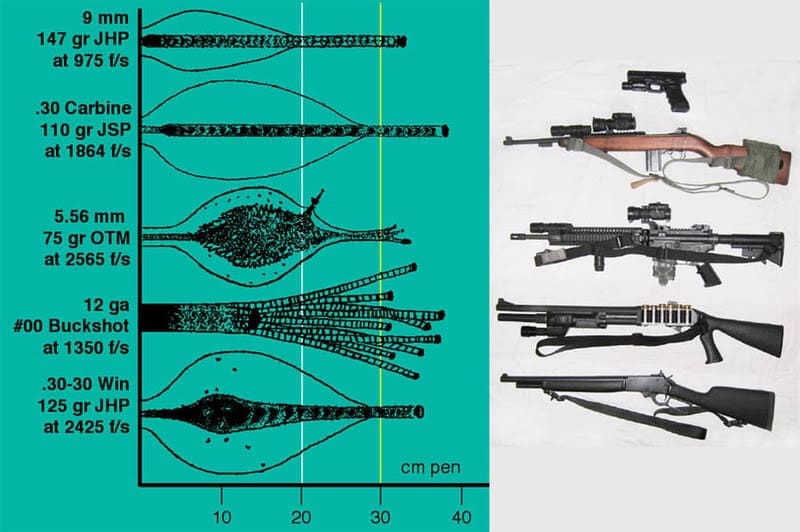
Photo courtesy of Dr Gary Roberts.
Pistols can provide excellent maneuverability, decent capacity, but are the worst performers of the three. Modern ballistic ammunition designs provide wound channels that are indistinguishable between 9mm, .40, and .45 acp. I will repeat that – Modern pistol ammunition design places 9mm, .40, and .45 acp all roughly within the same performance of each other. With that in mind- 9mm allows for greater capacity (gun dependent) and less recoil which means getting back on target for faster follow up shots.
Modern effective defensive pistol ammunition provides a combination of penetration and expansion while retaining mass; that combination with shot placement provides the desired results though narrow permanent wound channels. If pistol ammo is without mass to begin with or the bullet comes apart causing a smaller main projectile the penetration suffers. Frangible ammunition also falls within this category as less effective. Very light and fast pistol ammunition has been introduced many times to the market and it still does not replace modern defensive/duty hollow point ammunition. If you are wondering what specific ammunition to use, contact your local police department and find out what they issue. Ballistically handgun projectiles tend to travel through multiple residential walls fairly easily, causing them to be dangerous for use indoors for other people on the other side of those walls.
Shotguns are a favorite for many for home defense. The size of a shotgun does not stop it from being able to be used, but some configurations with longer barrels cause issues in confined spaces. Shotguns can have a slower follow up shot compared to the other two options as well as a limited capacity and very slow reloading. Unfortunately shotguns are a more complicated weapon to use under stress without training compared to the other two options. They are not a simple point and shoot weapon – you still need to use the sights. The sound of just racking a shotgun will not stop a determined attacker – don’t do it. Murphy’s Law says you will face the determined attacker.
Ammunition choices for shotguns provide many options. Duty ammunition fired at a single attacker can be devastating causing wider permanent wound channels (depending on distance to target). Bird shot is a bad idea due to lack of penetration – it will not stop a determined attacker just like the pistol ammo without mass. There are studies that place #4 shot all the way to slugs as effective to stop an attacker. Ammunition deemed to be effective to stop determined assailants also has the danger of penetrating multiple residential walls making it a less than optimal choice for home defense.
For this next section, I am going to use a 16” AR15 as the example for carbines. Depending on where you live, you can have reliable magazines from X capacity to Magpul’s new D60 (I said reliable). Being semiautomatic no additional actions are needed to fire once it is loaded and the safety is switched off. AR15’s have lower recoil than other weapons which allows for faster follow up shots. The design of the weapon allows for easy use within confined areas as well as increased accuracy. AR15’s are the best option for use against multiple assailants.
Depending on your choice of ammunition, you can have that combination of sufficient penetration and permanent wound channels on aggressors without excessive over penetrating residential walls like pistols and shotguns will do if you miss. That training will reduce the chance of you missing by the way.
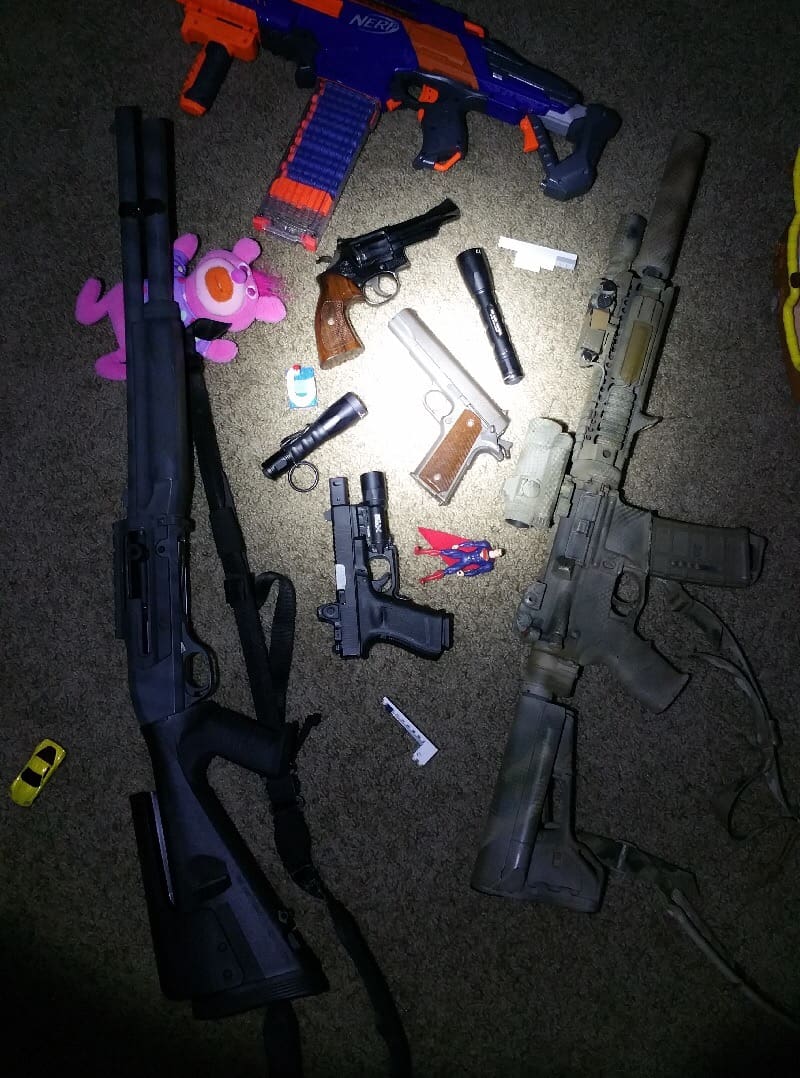
So here is the score:
Pistols are smallest, have less death power and more penetration of walls.
Shotguns can be devastating on a single target with duty ammunition; they are slow with limited capacity and can penetrate walls.
Carbines have most capacity, most accurate, most stable shooting platform (less recoil), provide desired ballistic results, less penetration than other options with walls.
No matter what you choose, go with a proven option. Don’t settle on junk when your family may depend on you and the performance of that weapon. Store your weapons so they are accessible to you without being a danger to those that shouldn’t have access. Get training. Don’t buy another gun – get better with what you have. Follow those firearms rules as outlined – be sure of your target, identify the target is indeed a threat.
This article was originally published on www.primaryandsecondary.com and reprinted with permission from Matt who retains the Copyright to his work.


